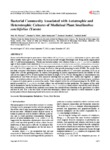Por favor, use este identificador para citar o enlazar este ítem:
http://www.alice.cnptia.embrapa.br/alice/handle/doc/941315Registro completo de metadatos
| Campo DC | Valor | Lengua/Idioma |
|---|---|---|
| dc.contributor.author | MORAES, R. M. | pt_BR |
| dc.contributor.author | MELO, I. S. de | pt_BR |
| dc.contributor.author | SUMYANTO, J. | pt_BR |
| dc.contributor.author | CHANDRA, S. | pt_BR |
| dc.contributor.author | JOSHI, V. | pt_BR |
| dc.date.accessioned | 2012-12-05T11:11:11Z | pt_BR |
| dc.date.available | 2012-12-05T11:11:11Z | pt_BR |
| dc.date.created | 2012-12-05 | pt_BR |
| dc.date.issued | 2012 | pt_BR |
| dc.identifier.citation | American Journal of Plant Sciences, v. 3, n. 10, p. 1382-1389, 2012. | pt_BR |
| dc.identifier.uri | http://www.alice.cnptia.embrapa.br/alice/handle/doc/941315 | pt_BR |
| dc.description | Several unfruitful attempts to grow axenic shoot cultures of Smallanthus sonchifolius, also known as yacon, were made before healthy shoots grew in association with bacteria on half strength Murashigue and Skoog media supplemented with 2.2 µM benzylaminopurine. Twenty-one bacterial isolates were obtained from in vitro S. sonchifolius plantlets, eight of these isolates were identified as Flavimonas oryzihabitans, Curtobacterium pusillum, Sphingomonas paucimobilis, and Microbacterium imperiale. These microorganisms produced indole acetic acid (IAA) at amounts varying between 8.89 to 47.45 µg/mL, reason for being classified as plant growth promoting bacteria (PGPB). The results show that buds associated with bacteria cultured on sucrose free media produced 3.77 new roots measuring 18.33 cm in length after a 30-day growing period. In contrast, buds growing on sucrose supplemented media, the number of roots induced was higher (6.67 to 14 roots/explant) but shorter in length, 4.67 to 5.83 cm. During plant acclimatization to soil, photosynthesis and water efficiency were measured showing that the plants were healthy and vigorous. A slightly higher rate of photosynthesis and water use efficiency was recorded in the plants produced on heterotrophic conditions as compared to plants grown in sucrose free media. Plants adapted well in the soil demonstrating that the PGPB community associated to S. sonchifolius in shoot cultures was not harmful to plant production. The purpose of this study was to demonstrate that the bacteria associated with in vitro S. sonchifolius shoot cultures was not the result of microbial contamination, but rather from symbiotic associations that extended from cultivation in the greenhouse, to culture and back to soil. This is the first report to show that autotrophic cultures may represent a viable alternative to grow healthy plants without eliminating beneficial bacteria associated with the host. | pt_BR |
| dc.language.iso | eng | eng |
| dc.rights | openAccess | eng |
| dc.subject | Yacon | pt_BR |
| dc.subject | IAA | pt_BR |
| dc.subject | Çido indolacético | pt_BR |
| dc.title | Bacterial community associated with autotrophic and heterotrophic cultures of medicinal plant smallanthus sonchifolius (Yacon). | pt_BR |
| dc.type | Artigo de periódico | pt_BR |
| dc.date.updated | 2012-12-05T11:11:11Z | pt_BR |
| dc.subject.thesagro | Planta medicinal | pt_BR |
| dc.subject.thesagro | Bactéria | pt_BR |
| dc.subject.nalthesaurus | Micropropagation | pt_BR |
| dc.subject.nalthesaurus | Endophytes | pt_BR |
| dc.subject.nalthesaurus | Smallanthus sonchifolius | pt_BR |
| dc.subject.nalthesaurus | Indole acetic acid | pt_BR |
| riaa.ainfo.id | 941315 | pt_BR |
| riaa.ainfo.lastupdate | 2012-12-05 | pt_BR |
| dc.contributor.institution | RITA M. MORAES, University of Mississippi; ITAMAR SOARES DE MELO, CNPMA; JOKO SUMYANTO, University of Mississippi; SUMAN CHANDRA, University of Mississippi; VAISHALI JOSHI, University of Mississippi. | pt_BR |
| Aparece en las colecciones: | Artigo em periódico indexado (CNPMA)  | |
Ficheros en este ítem:
| Fichero | Descripción | Tamaño | Formato | |
|---|---|---|---|---|
| 2012AP37.pdf | 1,44 MB | Adobe PDF |  Visualizar/Abrir |









